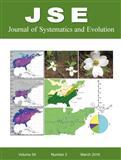Ashley Call, Yan-Xia Sun, Yan Yu, Peter B. Pearman, David T. Thomas, Robert N. Trigiano, Ignazio Carbone, Qiu-Yun (Jenny) Xiang
Repeated global climatic cooling and warming cycles during the Pleistocene played a major role in the distribution and evolution of the Earth biota. Here, we integrate phylogeography, coalescent-based Bayesian estimation of demographic history, and species distribution modeling (SDM) to understand the genetic patterns and biogeography of the flowering dogwood, Cornus florida subsp. florida L., since the Last Glacial Maximum (LGM). Natural populations of the species are severely threatened by dogwood anthracnose. We genotyped 306 plants from 73 locations of the species across most of its native distribution with three DNA regions from the plastid genome, ndhF-rpl32, rps16 and trnQ-rps16. The genealogy and haplotype network reconstruction revealed two haplotype lineages diverging ≈3.70 million years ago. We detected no clear geographic structuring of genetic variation, although significant local structure appeared to be evident, likely due to a combination of substantial localized seed dispersal by small mammals and small population size/limited sampling at a location. The spatial distribution of haplotype frequencies, estimated population demographic history, and results from hindcasting analysis using SDM suggested refugia in southeastern North America and population reduction during the LGM, followed by rapid post-glacial expansion to the north. Forecasting analysis using SDM predicted range shifts to the north under ongoing global warming. Our results further suggested that gene flow via seed dispersal has been high but insufficient to counter the effect of genetic drift. This study demonstrates the benefit of integrating genetic data and species distribution modeling to obtain corroborative evidence in elucidating recent biogeographic history and understanding of genetic patterns and species evolution.

